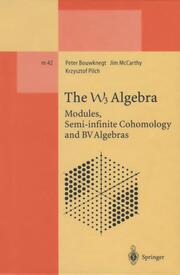Detailansicht
The W3 Algebra
Modules, Semi-infinite Cohomology and BV Algebras, Lecture Notes in Physics Monographs 42
ISBN/EAN: 9783662140925
Umbreit-Nr.: 5903239
Sprache:
Englisch
Umfang: xi, 204 S.
Format in cm:
Einband:
kartoniertes Buch
Erschienen am 31.12.2013
Auflage: 1/1996
- Zusatztext
- The study of W algebras began in 1985 in the context of two-dimensional conf- mal field theories, the aim being to explore higher-spin extensions of the Virasoro algebra. Given the simultaneous growth in the understanding of two-dimensional metric gravity inspired by analyses of string models, it was inevitable that these algebras would be applied to give analogues of putative higher-spin gravity t- ories. This book is an exposition of the past few years of our work on such an application for the algebra: in particular, the BRST quantization of the n- critical 4D string. We calculate the physical spectrum as a problem in BRST cohomology. The corresponding operator cohomology forms a BV algebra, for which we provide a geometrical model. The algebra has one further generator, of spin three, in addition to the (spin two) energy-momentum tensor which generates the Virasoro algebra. C- trary to the Virasoro algebra, it is an algebra defined by nonlinear relations. In deriving our understanding of the resulting gravity theories we have had to - velop a number of results on the representation theory of W algebras, to replace the standard techniques that were so successful in treating linear algebras.
- Kurztext
- W algebras are nonlinear generalizations of Lie algebras that arise in the context of two-dimensional conformal field theories when one explores higher-spin extensions of the Virasoro algebra. They provide the underlying symmetry algebra of certain string generalizations which allow the extended world sheet gravity. This book presents such gravity theories, concentrating on the algebra of physical operators determined from an analysis of the corresponding BRST cohomology. It develops the representation theory of W algebras needed to extend the standard techniques which were so successful in treating linear algebras. For certain strings corresponding to WN gravity we show that the operator cohomology has a natural geometric model. This result suggests new directions for the study of W geometry.
